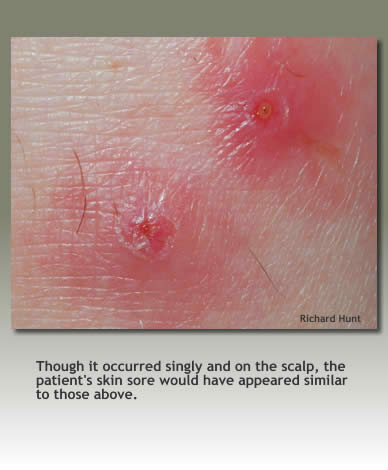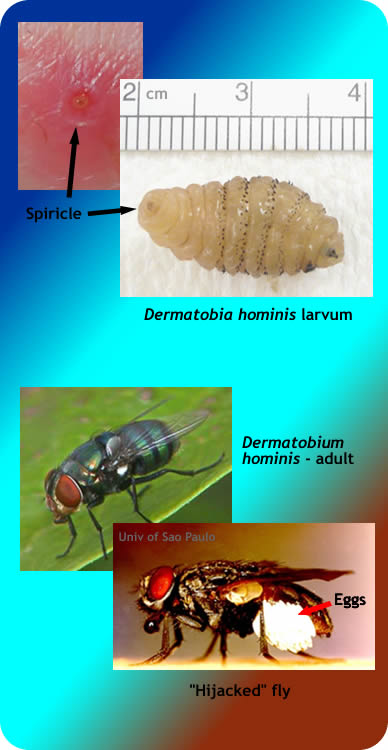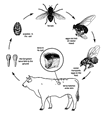Infectious Diseases Case of the Month #20 |
|||
 |
A 62 y.o. white male developed a painful draining lump on the vertex of his scalp after vacationing in Belize in the winter of 2007-2008. He and his wife, ecotourists, spent thirteen days in Belize. The first four days were spent on barrier islands off the coast, and the last nine days were spent at a "jungle lodge" in the humid coastal lowlands. While on the islands they engaged in snorkeling and in the coastal lowlands they explored the jungle flora and fauna. The patient was unaware of any injury he sustained related to contact with coral or marine creatures. Mosquito netting was used at night in both locations, and insect repellents were used during the days. He wore a hat when outside in the jungle. He recalled no insect bites when he was on the islands. He was aware of being bitten by insects on his wrists and his ankles while exploring the jungle although he never saw the biting insects. He waded up to his knees in a fresh water stream, ate food prepared by local lodge keepers, and drank water from a mountain spring that he was assured was safe. Prior to travel he had received appropriate immunizations, and he took chloroquine prophylaxis for malaria. He first noticed the then slightly painful bump on his scalp about ten days after his return from Belize. It progressively enlarged, was episodically more painful, and began to drain. He eventually sought attention from his primary physician who manipulated the scalp lesion with a needle which seemed to make it more painful. Ultimately he was referred to a surgeon who incised and explored the lesion. Before surgical incision the patient's sore would have appeared similar to one of those pictured at left. |
||
What was the cause of this patient's skin lesion? |
|||
 |
This traveler to Belize was a victim of myiasis secondary to Dermatobia hominis, the human botfly. As the surgeon incised the raised lesion, movement was noted within the wound. Further exploration revealed the larvum which was extracted (see photo at left).
Surgical extraction is one method of removing the Dermatobia hominis larvum, but often this is not necessary. Application of petroleum jelly to the respiratory spiracle (see upper images at left) may smother the larvum such that it will begin to emerge and then can be extracted with forceps. An internet search will reveal a number of first person accounts of such extractions sometimes complete with video! Dermatobia hominis is found in Central and South America (map). In addition to parasitizing humans it is a significant cause of myiasis of livestock. The Tumbu Fly (Cordylobia anthrophaga) causes human myiasis in areas of Africa. Other species of fly can cause myiasis complicating open wounds; on occasion myiasis has been used therapeutically to debride necrotic wounds.The other organisms listed as choices in the preceding vignette are all capable of causing skin lesions. Careful inspection of the patient's raised lesion, however, would have revealed the respiratory spiracle, a feature unique to the human botfly (Dermatobia) amongst the available choices. Ref: The Diptera Site, Systematic Entomology Laboratory, ARS, USDA |
||
| Home Case of the Month ID Case Archive | Your Comments/Feedback | ||
 The life cycle of Dermatobia hominis is very interesting. The adult fly attaches its eggs to the bodies of other insects, principally mosquitos and other biting flies (see lowermost image at left). To do so, the human botfly captures the the other insect in flight, and the eggs are attached in such a fashion as to not interfere with the aerodynamic performance of the "host" insect's flight. When the vector insect then lands on a human or other animal host, the eggs hatch and larva enter through a bite wound created by the vector insect or by directly burrowing into the skin of the victim. Over a period of five to ten weeks the larva mature before emerging to fall to the ground to pupate. As pictured, the larva develop to be of substantial size. Humans so parasitized will experience pain and draining wounds, and may even perceive subcutaneous movement of the larvum. In most cases although unnerved, humans suffer no significant sequelae of this particular version of myiasis. Click
The life cycle of Dermatobia hominis is very interesting. The adult fly attaches its eggs to the bodies of other insects, principally mosquitos and other biting flies (see lowermost image at left). To do so, the human botfly captures the the other insect in flight, and the eggs are attached in such a fashion as to not interfere with the aerodynamic performance of the "host" insect's flight. When the vector insect then lands on a human or other animal host, the eggs hatch and larva enter through a bite wound created by the vector insect or by directly burrowing into the skin of the victim. Over a period of five to ten weeks the larva mature before emerging to fall to the ground to pupate. As pictured, the larva develop to be of substantial size. Humans so parasitized will experience pain and draining wounds, and may even perceive subcutaneous movement of the larvum. In most cases although unnerved, humans suffer no significant sequelae of this particular version of myiasis. Click